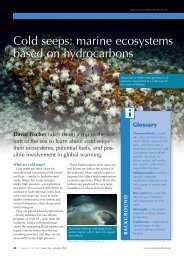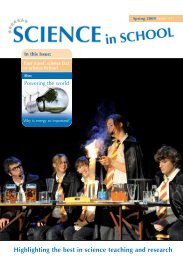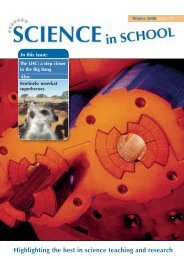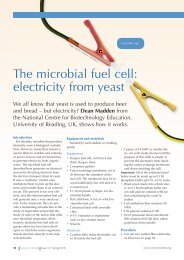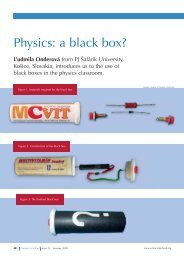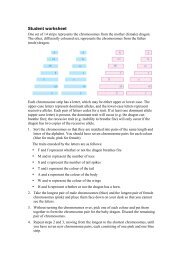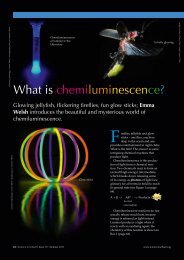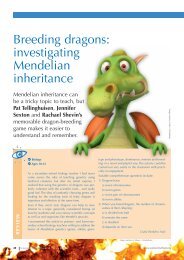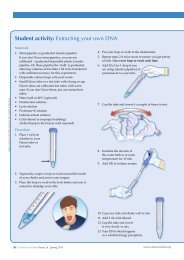Download Issue 14 as PDF [5.4 MB] - Science in School
Download Issue 14 as PDF [5.4 MB] - Science in School
Download Issue 14 as PDF [5.4 MB] - Science in School
Create successful ePaper yourself
Turn your PDF publications into a flip-book with our unique Google optimized e-Paper software.
Cutt<strong>in</strong>g-edge science<br />
Image courtesy of L. Shyamal; image source: Wikimedia Commons<br />
Microhyla ornata frog from Savandurga, India.<br />
These frogs are also found <strong>in</strong> elephant dung<br />
At<br />
first glance,<br />
Vrijenhoek and his<br />
team <strong>as</strong>sumed that the worms on the<br />
bones were just one or two species all<br />
do<strong>in</strong>g roughly the same th<strong>in</strong>g, yet<br />
that number quickly expanded to five<br />
species <strong>in</strong> the years follow<strong>in</strong>g the<br />
worm’s discovery, and <strong>in</strong> 2009, the<br />
number jumped to seventeen. This<br />
led the team to theorise that there<br />
might be more than one way for a<br />
worm to feed on a bone.<br />
None of the worms have mouths or<br />
anuses. Instead, they all have a bulbous<br />
root system that they embed <strong>in</strong><br />
the bones, and a variety of different<br />
feathery structures that the<br />
researchers th<strong>in</strong>k are be<strong>in</strong>g used<br />
for respiration (see image on page 30).<br />
Exactly how the worms draw out<br />
nutrients from bones is still someth<strong>in</strong>g<br />
of a mystery, but the large number<br />
of new worms found <strong>in</strong> 2009 have<br />
so many different forms and body<br />
structures that the researchers are<br />
beg<strong>in</strong>n<strong>in</strong>g to suggest that the ocean<br />
floor h<strong>as</strong> an entire ecosystem of bone<br />
feeders of different sizes and shapes<br />
which likely have different tactics for<br />
feed<strong>in</strong>g on bones.<br />
A species that is mak<strong>in</strong>g this po<strong>in</strong>t<br />
most clearly is one of the newly discovered<br />
worms which, at first glance,<br />
seems to embed itself <strong>in</strong> sediment<br />
rather than bone. Yet <strong>as</strong> the research<br />
team went to look closer, they found<br />
that these worms, although anchor<strong>in</strong>g<br />
<strong>in</strong> sediment, had very long root systems<br />
that ran out to buried bone fragments.<br />
They were effectively function<strong>in</strong>g<br />
<strong>as</strong> buried bone-shard feed<strong>in</strong>g specialists,<br />
mak<strong>in</strong>g them quite different<br />
from the other bone-feed<strong>in</strong>g worms<br />
which have all been found directly<br />
embedd<strong>in</strong>g themselves <strong>in</strong> bones. The<br />
team expects that <strong>as</strong> they further<br />
study the new worms, even more<br />
diversity will be uncovered.<br />
Further exploration of the worms<br />
and their behaviours is def<strong>in</strong>itely<br />
needed, but for the moment, it looks<br />
<strong>as</strong> if there is an entire world of bone<br />
feeders <strong>in</strong> the ocean depths.<br />
REvIEW<br />
Biology<br />
Ecology<br />
Discover<strong>in</strong>g new species is not all<br />
there is to biodiversity. Discover<strong>in</strong>g<br />
new ways <strong>in</strong> which already known<br />
species <strong>in</strong>teract is equally important,<br />
and from this perspective, 2009 w<strong>as</strong><br />
one of the more f<strong>as</strong>c<strong>in</strong>at<strong>in</strong>g years, <strong>as</strong><br />
research h<strong>as</strong> revealed that the presence<br />
or absence of elephant faeces<br />
plays an important role <strong>in</strong> bio -<br />
diversity.<br />
In Sri Lanka, Asian elephants are<br />
cont<strong>in</strong>ually be<strong>in</strong>g pushed out of<br />
forests and isolated from regions<br />
where they are seen <strong>as</strong> troublemakers.<br />
To be fair, there is a lot of truth to this:<br />
the elephants readily destroy trees<br />
if left <strong>in</strong> an area for long enough.<br />
However, Ahimsa Campos-Arceiz<br />
at the University of Tokyo, Japan,<br />
revealed l<strong>as</strong>t year that the elephants<br />
appear to be giv<strong>in</strong>g back to their<br />
This article is very ple<strong>as</strong>ant to read and will probably give a whole<br />
new mean<strong>in</strong>g to the term ‘biodiversity’ to most readers. The scope<br />
is to show that biodiversity is by far richer than we can possibly<br />
imag<strong>in</strong>e; to prove this, the author provides examples that will surprise<br />
and even amuse the reader.<br />
The article could be useful <strong>in</strong> the study of ecology and specifically<br />
<strong>in</strong> the exam<strong>in</strong>ation of the behaviour of and the relationships<br />
between different species of organisms, <strong>as</strong> it suggests ‘unconventional’<br />
ways <strong>in</strong> which organisms <strong>in</strong>teract with each other and with<br />
the environment.<br />
The article could be used to discuss biodiversity and particularly the<br />
various forms it can take. Comprehension questions could <strong>in</strong>clude:<br />
1. Biodiversity is a complex term. Expla<strong>in</strong> three forms that biodiversity<br />
can take, giv<strong>in</strong>g one example for each.<br />
2. In the article, there is a claim that elephant dung could become<br />
a small ecosystem. Do you agree or disagree with this claim?<br />
Expla<strong>in</strong> the re<strong>as</strong>ons for your decision.<br />
3. Describe a specific behaviour adopted by certa<strong>in</strong> species of seaweed<br />
that helps them defend aga<strong>in</strong>st pathogens when they are<br />
damaged.<br />
Michalis Hadjimarcou, Cyprus<br />
Image courtesy of proxym<strong>in</strong>der / iStockphoto<br />
Image courtesy of Smithore / iStockphoto<br />
www.science<strong>in</strong>school.org <strong>Science</strong> <strong>in</strong> <strong>School</strong> <strong>Issue</strong> <strong>14</strong> : Spr<strong>in</strong>g 2010 29


![Download Issue 14 as PDF [5.4 MB] - Science in School](https://img.yumpu.com/26126440/31/500x640/download-issue-14-as-pdf-54-mb-science-in-school.jpg)


